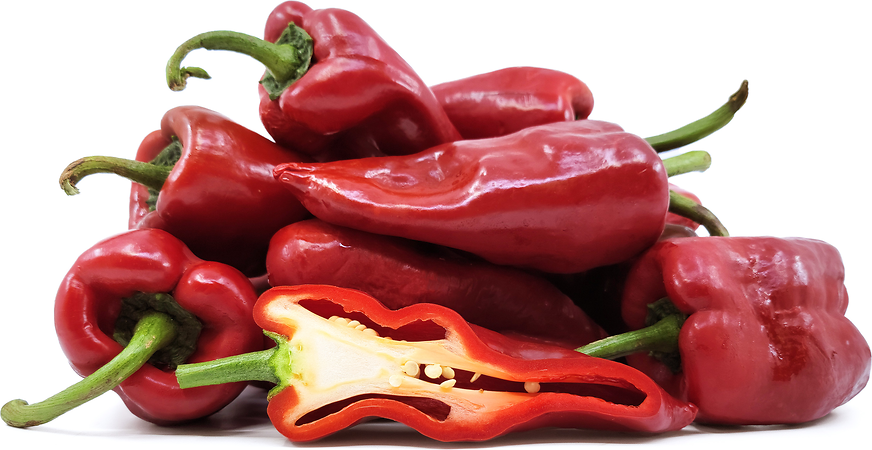


Red Pasilla Chile Peppers
Estimated Inventory, lb : 0
Description/Taste
Red Pasilla chile peppers are large, curved to straight pods, averaging 12 to 22 centimeters in length, and have a wide, conical shape that tapers to a rounded point on the non-stem end. The skin is glossy, smooth, and taut, covered in prominent folds and creases. The skin also ripens from dark green to red when mature. Underneath the surface, the flesh is thick, crisp, aqueous, and red, encasing a central cavity filled with round and flat, cream-colored seeds. Red Pasilla chile peppers have an earthy, sweet, and smoky flavor mixed with a mild level of spice.
Seasons/Availability
Red Pasilla chile peppers are available in the summer through early fall.
Current Facts
Red Pasilla chile peppers, botanically classified as Capsicum annuum, are a popular cooking variety that belongs to the Solanaceae or nightshade family. When found fresh in markets, the red peppers labeled as Pasilla are actually mislabeled and are truly red poblano peppers. It is unknown how Pasilla came to be used interchangeably with poblano in fresh markets, but the two peppers are distinct varieties and have varying appearances and flavors. True Pasilla chile peppers are the dried, wrinkled pods of the chilaca chile pepper, which is a long and spicy pepper, while poblanos are broad, thick, and mild, fresh peppers. In northern Mexico and the southwestern United States, Red Pasilla chile peppers are often also labeled as mature poblano peppers and have a mild to medium level of heat, ranging 1,000-2,000 SHU on the Scoville scale. The ripe peppers can be cultivated for fresh use, but they are more popularly grown to be dried and used as a flavoring for sauces and soups.
Nutritional Value
Red Pasilla chile peppers are an excellent source of vitamin C, which is an antioxidant that can help boost the immune system and is a good source of vitamins A and B6, manganese, and fiber. The peppers also contain potassium, iron, and folate.
Applications
Red Pasilla chile peppers, or mature poblanos, are consumed in cooked applications such as grilling, roasting, and baking. Cooking the Red Pasilla tenderizes the firm flesh of the pepper and brings out a deeper pepper flavor and smoky undertones. The peppers are commonly utilized as a stuffed pepper and are filled with beans, cheeses, potatoes, cream sauce, eggs, seafood, and pork, then baked or fried. In Mexican cuisine, Red Pasilla chile peppers are also commonly roasted or dried and used to make enchilada, adobo, or mole sauces. Red Pasilla chile peppers pair well with onions, garlic, herbs such as cilantro, epazote, and oregano, earthy flavors such as mushrooms, toasted almonds, cocoa, and cheeses such as feta, queso panela, and cotija. Fresh peppers will keep 1-2 weeks when loosely stored whole and unwashed in a paper or plastic bag in the refrigerator.
Ethnic/Cultural Info
In Mexico, Red Pasilla chile peppers are primarily dried and used as a flavoring in sauces and soups. Known as ancho chiles when dried, ancho means “wide” in Spanish and is derived from the dried pepper’s broad and flat shape. Ancho chile peppers are considered to be a staple, sweet and smoky flavor in Mexican cuisine and are popularly blended with sour cream to make a thick, smoky, and mildly spicy sauce that has a raisin-like fragrance. This sauce can be used in any recipe calling for regular sour cream such as a topping over potatoes, tacos, chilis, and stews. Ancho chile peppers can also be used to make enchilada sauces and can help thicken salsas.
Geography/History
Red Pasilla chile peppers are believed to have originated in the Puebla region of central Mexico just south of Mexico City and have been cultivated since ancient times. Today it is one of the most common chiles grown in Mexico with the bulk of commercial production coming out of Aguascalientes, Zacatecas, Jalisco, and Guanajuato. Red Pasilla chile peppers can be found through specialty grocers, farmer’s markets, and through online seed catalogs for home garden use in Central America, Mexico, and the United States.




